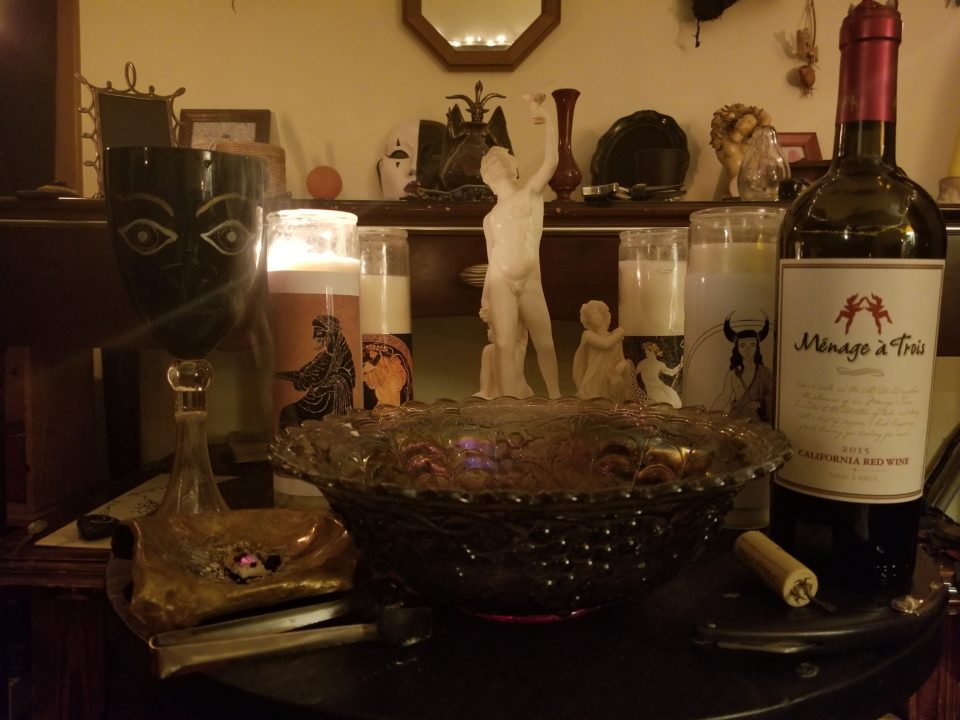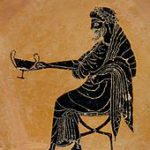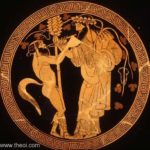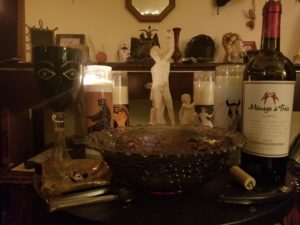Last night I completed the first week of the December Do Magick Challenge. In doing so, I completed a week of prayer to and meditation with the god Dionysos. I have poured wine, drank wine, burned frankincense, and offered long-burning votive candles. I have read Homeric hymns, Orphic hymns, modern hymns. I have played music, and I have sat in silence. I have felt both the presence and the absence of the god. I have been numb, and I have been reamed out, and I have been brought to outbursts of both tears and laughter.
I have been so overwhelmed by the Christmas Holiday that I lost count of the days and doubled up on the fifth without realizing it. So today was my eighth day of Dionysos. But I think I needed it.
The intensity of the experience built quickly, with each of the first four days being much more intense than the last. The next three days were less and less intense, but more and more lucid. So much so (on both counts) that I found myself doubting the experiences, as they were, in many ways, too much what I hoped for an expected. Tonight was the natural culmination of that arc, with the god saying clearly what it is that he wants and expects from me.
There are so many bits and pieces. So many stories I could tell if only I had the words.
On a somewhat technical note, I have determined that, of the hymns I’ve found so far, the ones that move me best are the Orphic Hymns as translated by Apostolos N. Athanassakis. In particular, I adore hymns 30. To Dionysos, 42. To Mise, and 45. To Dionysos Bassareus and Triennial. Together, these three hymns invite the god to show up in his/her two mixed-gender incarnations, attend the initiates, and bring the party.
Probably the most interesting to people who are not me is Dionysus’ claim to the patronage of all the arts I pursue, not just the “theatre” of my storytelling. I have always looked to Hephaestos as the patron of my jewelry arts, so this gave me a bit of pause; the ever estimable Jack Faust pointed me toward the Kabeiroi, sons of Hephaestos who were both master craftsmen and Bacchic revelers, as an intercessory force in that regard. The notion of Dionysiac photography is more interesting still — very much the exploration of myth, ritual, and identity that I aspire to pursue.
Less interesting, but more personally relevant, is the question of my relationship with the god. As someone who has very little personal background in worship, but a great deal of background in sorcery, I have often been at a loss for what the god might want from me in return for his blessings. The last two nights the answer to that has been a vague but (in theory) reassuring “what you’re doing is great.” Anyone who’s ever had a boss knows that’s not a phrase you can trust. Tonight, though, the image was made more clear. My role in this relationship is simply to worship … to drink wine, and make art, and make wine, and laugh and love and dance in his name. Dionysus does not want or need me to be a priest or a temple-keeper or an evangelist or even a satyr. I am a Maenad. I don the mantle. I perform the rites. I live and laugh and drink and dance and fuck for Dionysus. And when he moves on, I go back to my life until he returns. That is to say, he is content with our relationship as it stands, and to maybe dial it up a notch or two.
I also got an interesting sense of approval that I will be moving on from Dionysos to Baphomet. They share currents, it seems.






 I finally began building the altar for my first week of prayer this past Friday, when I no longer needed the altar room for this past week’s photo shoot. It’s fairly simple, at least to start. Having met me, it’s likely to grow to overtake the main altar. In the mean time, y’all should be proud of me that it’s not more over the top from the jump.
I finally began building the altar for my first week of prayer this past Friday, when I no longer needed the altar room for this past week’s photo shoot. It’s fairly simple, at least to start. Having met me, it’s likely to grow to overtake the main altar. In the mean time, y’all should be proud of me that it’s not more over the top from the jump.






